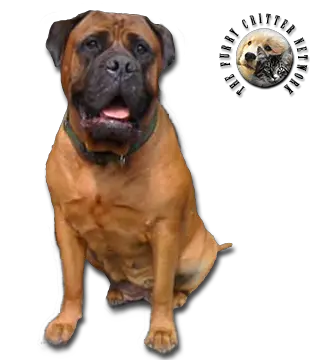Breed Standard
Head: Broad. Strong, square skull. Skin on face is wrinkled when dog is alert. Distinct stop. Well developed cheeks. Short, broad muzzle. Flews must not be pendulous.
Ears: Small, V-shaped, set on high and placed wide apart. Darker color than the rest of the coat.
Eyes: Medium size. Dark or hazel color.
Body: Powerful. Very muscular neck. Broad chest. Muscular shoulders.
Tail: Set high, strong at the base and tapering to the tip. Carried straight or curved and reaching the hocks.
Hair: Short, hard, close-lying.
Coat: Any shade of brindle, red, or fawn. White spot on the chest is acceptable. Black mask on the muzzle. Dark markings around the eyes.
Size: Dog: 63 to 68 cm. (25-27 in).Bitch: 61 to 66 cm. (24-26 in).
Weight: Dog: 50 to 59 kg. (110-130 lb).Bitch: 41 to 50 kg. (90-110 lb).
History
The Bullmastiff was bred to aid gamekeepers in protecting the game on large English estates. Poaching on the estates was an expensive problem for the landowners, and it was the gamekeeper's duty to catch the thieves. Gamekeepers needed a dog that could track quietly, cover short distances quickly, and pin and hold poachers without mauling them.
Gamekeepers experimented with several breeds, looking to the mastiff, who was too slow, and then the bulldog, who was at the time a more ferocious dog than he is today. Out of these breeds, the bullmastiff was born. He combined the best of both breeds for the job required of him. He is now primarily a family companion with a calm, dependable disposition when properly trained and socialized.
The Bullmastiff was recognized as a breed by The Kennel Club in 1924. Dogs had to have a minimum of four generations of descent from Bullmastiff stock without input from either Bulldog or Mastiff; cross-bred animals could not be registered. The American Kennel Club recognized it in 1934. It was accepted by the Federation Cynologique Internationale in 1955.
Behavior
Active, agile, showing great endurance and of solid build, the Bullmastiff has a symmetrical appearance. He is earnest, courageous and alert, making him an excellent guard dog. However, he is loyal and gentle, an excellent playmate for children. The Bullmastiff has a very keen sense of smell and a dominant personality. Early, firm, (though gentle) training is required. Bullmastiffs are strong, powerful but sensitive dogs. For a bullmastiff to become a well-behaved family member, consistency is needed. Training and socialization is of high importance. Dogs of this breed are natural guardians of their home and owners. No special guard training is needed for a bullmastiff to react appropriately if his family is endangered. Special approach to bullmastiff training is needed, because these dogs do not like to repeat the same actions again and again. Activities bullmastiffs can really enjoy are obedience, agility, tracking, and carting.
The Bullmastiff is a good house dog if he gets an abundance of exercise. Regular brushing of the coat and cleaning of his folds are required.
Function
Guard and Defense Dog, Police and Army Dog, Pet.
Health
Health concerns within the breed include hip and elbow dysplasia, progressive retinal atrophy, bloat, and cancer, with a relatively high incidence of lymphoma and mast cell tumours. Bullmastiffs are prone to certain hereditary diseases, including:
Hip dysplasia, affecting 24.5% of individuals
Elbow dysplasia, affecting 13.8% of individuals
Entropion, hypothyroidism affecting 2.8% of individuals
Lymphoma
Progressive retinal atrophy is a particular problem, since the trait is an autosomal dominant one. (This has recently been called into question by another medical team and has been proven that some Bullmastiffs have autosomal recessive PRA genes. In America, this is being investigated by the American Bullmastiff Health and Research Committee, and the DNA Optigen test only works for dominant genes, so it is considered inadequate at this time.)






